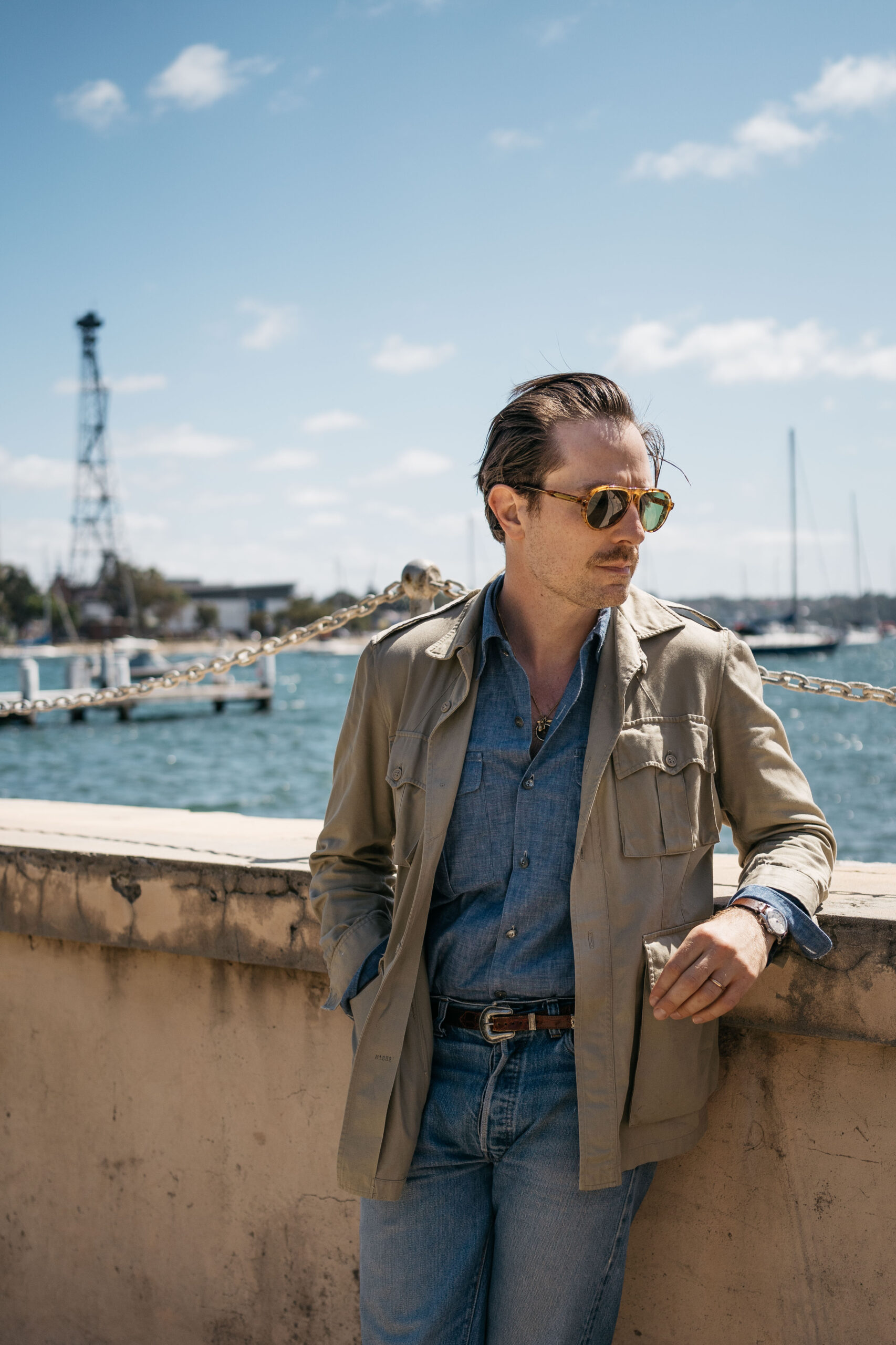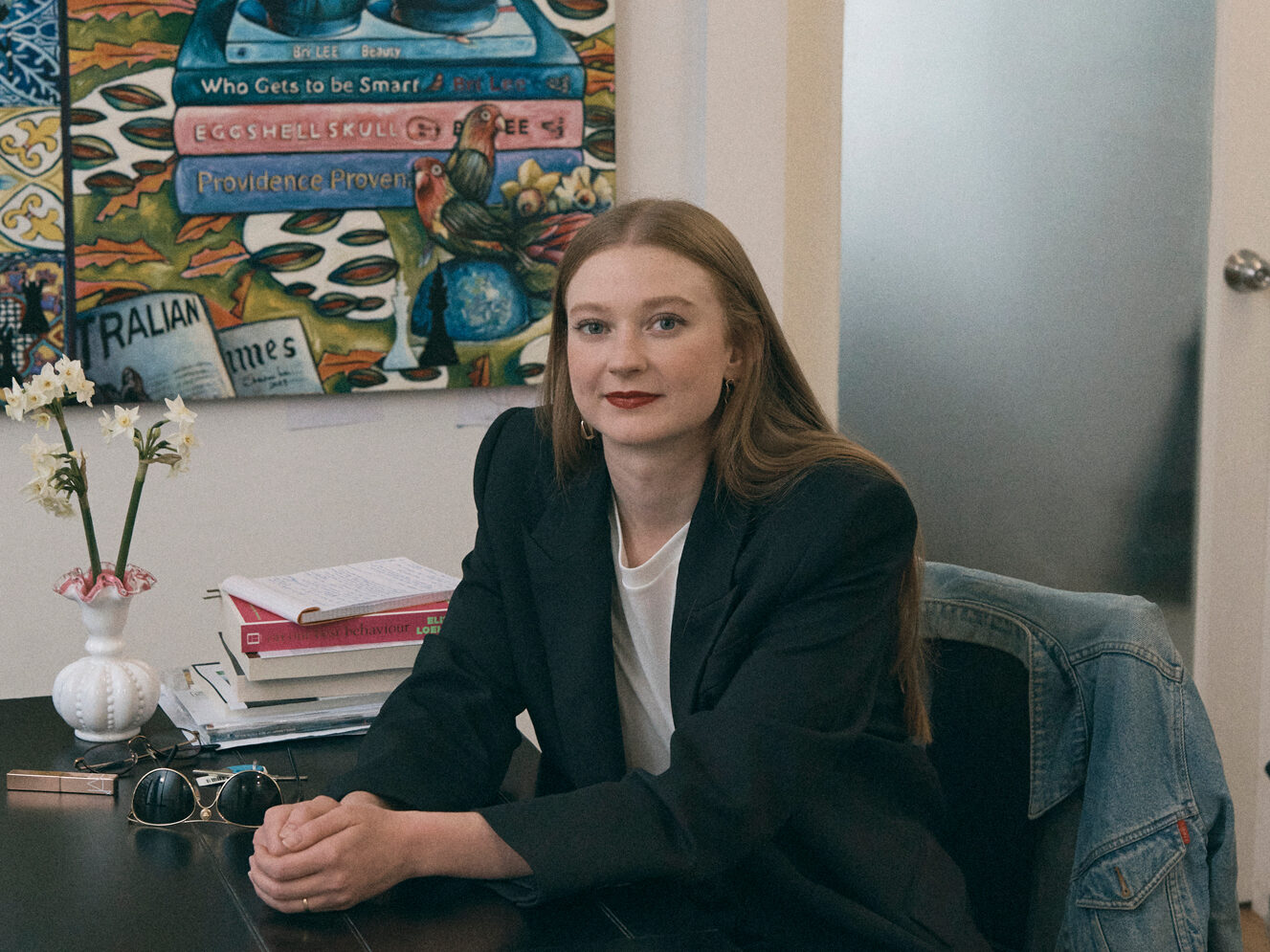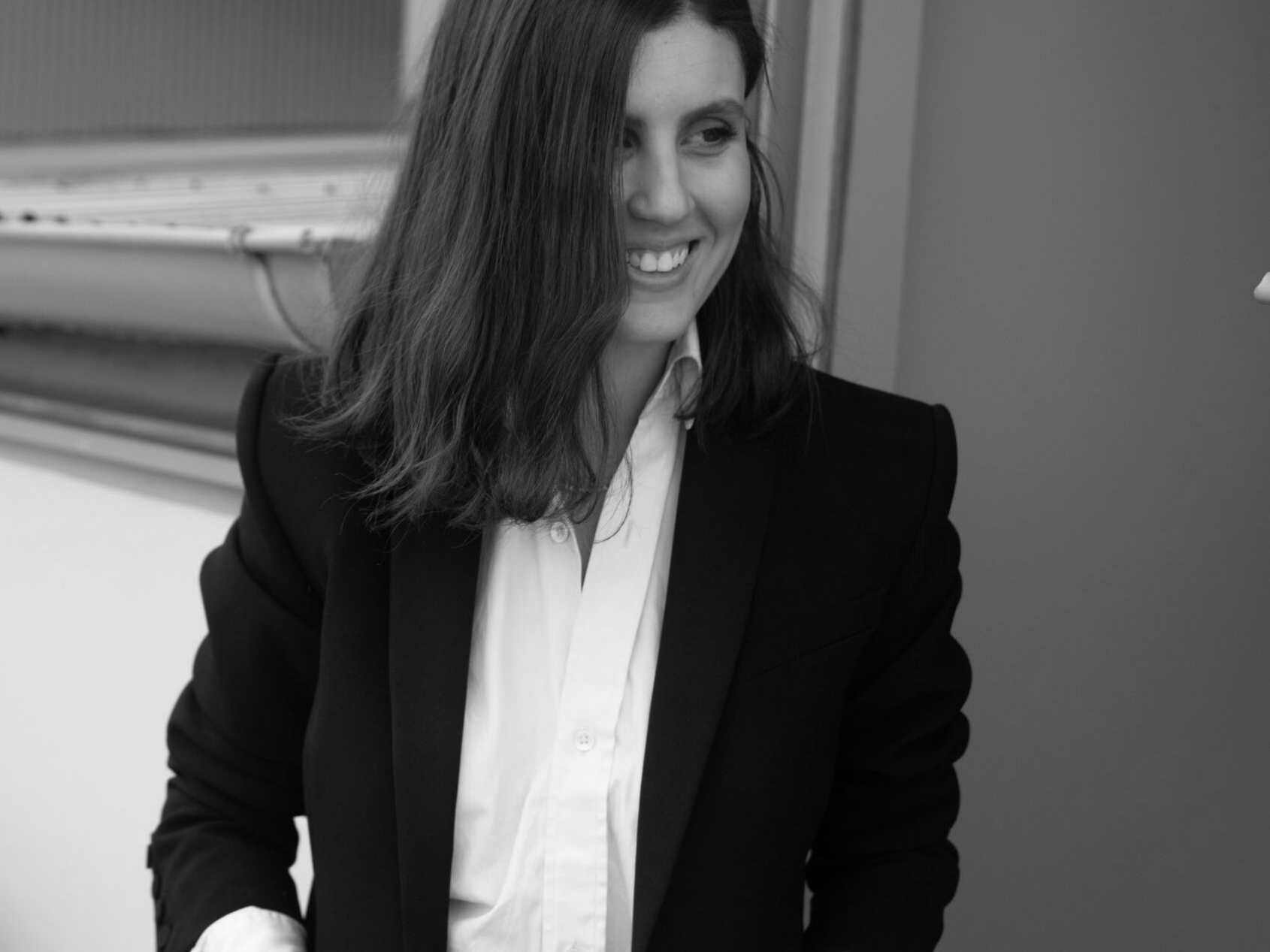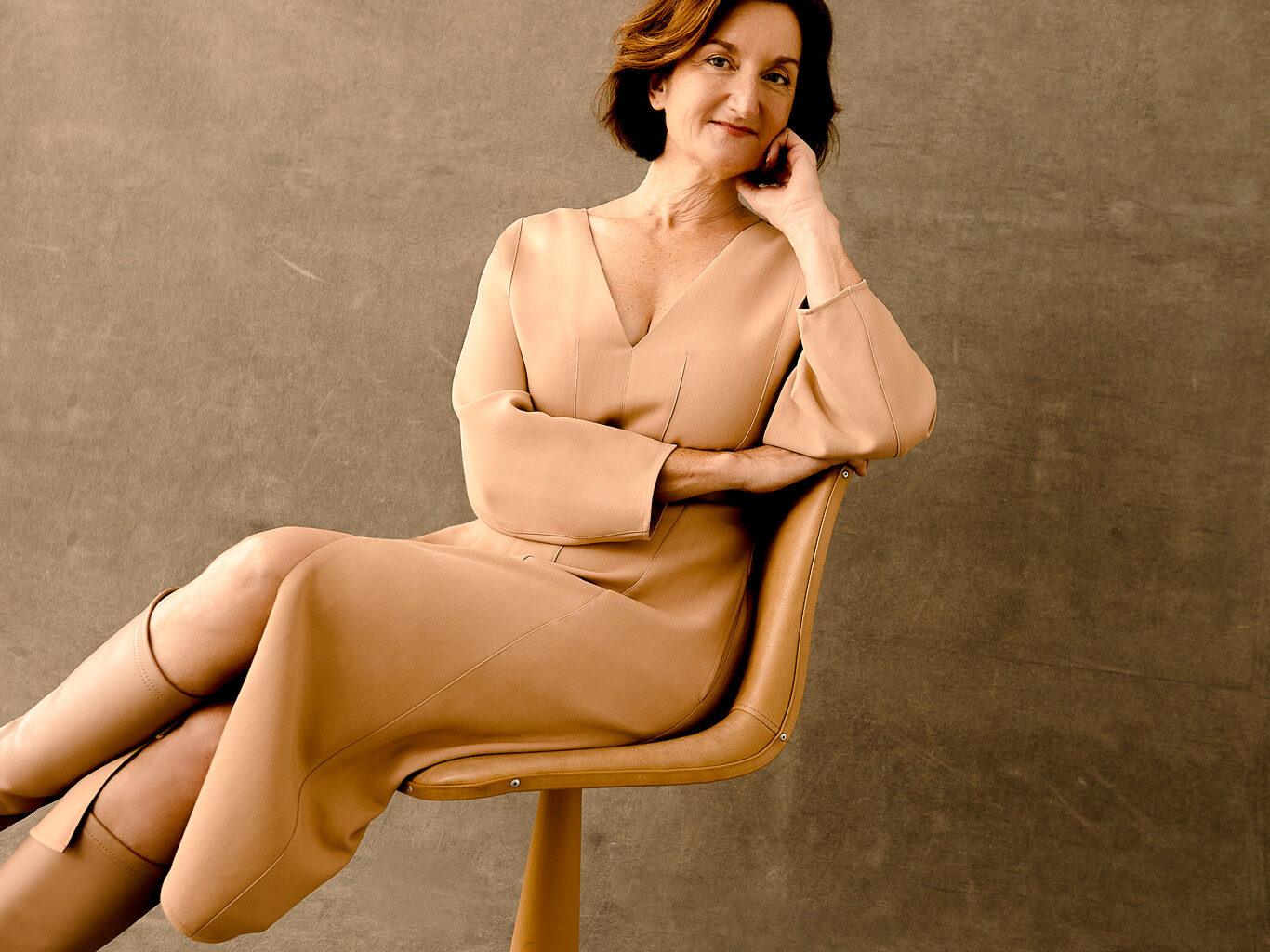“Each morning, I awake early to my four year-old daughter telling me that the sky is blue,” says the Creative Director and Designer Jeremy Hershan. “I check the weather to confirm if the sky is in fact going to be blue, [then] I plan my outfit in my head accordingly, while in the shower,” he adds. “This is nearly always anchored by my choice of footwear and involves a pair of heavily darned vintage Levis.”
Hershan is exacting and thoughtful, with an uncanny urbane stamp. Details matter to the designer, who worked in eminent studios across the world, before asserting his vocational calling in roles at a series of bespoke tailors and revered heritage design houses.
Hershan’s days are bookended with careful rituals. “I live about 300m from my studio in Redfern and will take the time to iron even my T-shirt on a day where I know I will see no one and have no meetings. I think Sir Hardy Amies said it best: ‘A man should look as if he’s bought his clothes with intelligence, put them on with care and then forgotten all about them’,” he quotes. Hershan’s quiet attentiveness imbues the everyday with a sense of quality—a characteristic that suffuses into his work.
Of his time working with legacy tailoring outfitters, he attests to the sense of rigour and precision that these experiences instilled in him, although these traits extend even further back to his childhood, where he developed an appreciation of craftsmanship from a young age. “I grew up with migrant European grandparents who were tailors, dress-makers and milliners…My grandfather trained as a tailor in London in the 1930s and specialised in sportswear of the day, and I aspired to follow in his footsteps.”
"I think Sir Hardy Amies said it best: ‘A man should look as if he’s bought his clothes with intelligence, put them on with care and then forgotten all about them’.”
Jeremy Hershan
"I think Sir Hardy Amies said it best: ‘A man should look as if he’s bought his clothes with intelligence, put them on with care and then forgotten all about them’.”
Jeremy Hershan
True to his grandparent’s legacy and his early aspirations, Hershan set out studying at RMIT in his hometown of Melbourne, where he focussed his practice on traditional men’s tailoring techniques. “I spent a lot of time on the construction of the jackets, focussing on the expression of the shoulder, setting the pitch of the sleeves and forming the roll of the lapel,” he says.
By his final year, Hershan’s affinity for tailoring and luxury design was cemented. He headed to Europe, where he was accepted to intern at the studio of Veroniqe Branquinho in Antwerp; an experience he cites as one that opened the door for him internationally. This six-month placement led him to an apprenticeship in Paris with Kris Van Assche, who at that time, was the Artistic Director of Dior Homme. “I professed to speak a little French in the interview with Kris, omitting the fact I had failed it in high school,” Hershan admits. “The team was entirely French-speaking, and from day one all conversations and instructions were in French. I worked long studio hours by day and took French classes by night—fitting in a little time to experience Paris of course! It was a long year,” he recounts, “but I learnt a hell of a lot, even if I could only understand half of it.”
Following his time in Paris, Hershan made his way to London for an opportunity to design at Gieves & Hawkes on Savile Row—one of the oldest bespoke tailors in the world. This was a seminal point in Hershan’s career, recalling it as “a dream opportunity” to hone his eye for tailoring, learn the codes of British dress and work alongside master craftspeople. “This instilled a sense of rigour and eye for quality, fit and construction that has directly shaped my work to this day,” he asserts.
This stint at Gieves & Hawkes led to posts at Aquascutum and Alfred Dunhill. “Both are classic British heritage brands with incredibly rich legacies,” he describes. In these positions, Hershan was tasked with revitalising and in turn, modernising each brand for a new generation—a pattern that would become a thread in his career.
Having worked at Dunhill for four years, Hershan was approached with the opportunity to lead design at the fabled Australian legacy brand R.M. Williams. Back in Australia, this time in Sydney, Hershan began to define a new chapter of the brand, continuing his trajectory of reinvigorating heritage houses—something he was garnering a reputation for. “The expectations of heritage and tradition versus the desire to create a modern and relevant brand aesthetic can be a delicate process,” he explains. “Tapping into the DNA of the brand, shedding new light to beautiful details and ideas from the past but through a contemporary lens is a crucial part of the process. It is a balancing act.”
It’s an act Hershan has a knack for, best exemplified now in his own brand, HAULIER International: a purveyor of luxury goods, with a penetrating focus on quality, historical manufacturing techniques and long-wearing character. With an offering that currently spans a meticulously crafted utility tote bag in sweep of colours, Hershan is in the process of developing a collection of ready-to-wear pieces, crafted to the same fastidious standards as his luggage. “I spent close to two years designing and prototyping the Utility Tote to a point where it met my expectations. I am now applying the same design philosophy and attention-to-detail to a wardrobe of enduring goods…taking the time to test the fits and quality,” he explains.
Traditional techniques inform the way Hershan designs his pieces. “For the Utility Tote bags,” he details, “I sought out the last antique shuttle looms of their kind in Europe in order to weave our signature 24oz cotton canvas to the precise dimensions of our bags, therefore eliminating any cutting waste in the process. Using these particular mid-century looms means the weaving process is very slow, but results in a quality, richness and density that you can not replicate with modern looms.”
“I spent close to two years designing and prototyping the Utility Tote to a point where it met my expectations."
Jeremy Hershan
“I spent close to two years designing and prototyping the Utility Tote to a point where it met my expectations."
Jeremy Hershan
Creative integrity and design necessity are central to the brand and it’s offering. Hershan starts his design process by interrogating what’s missing from his life and wardrobe, setting out on a path of research to begin developing each product. Fabrication is also a common starting point. “HAULIER is a very personal narrative and is my aesthetic to a tee,” says Hershan. “I am extremely passionate about story-telling and image creation so the campaign direction is something I delight in. The references I draw from reflect my passion for the films, music, photography, literature and celebrity culture of the 60s and 70s. HAULIER is inspired by this magical period – a timeless era where taking a trip on an airplane was a glamorous pursuit for everyone, and a time where travel and style went hand in hand.”
Hershan also notes these references as an antidote to creative block. The process of constantly absorbing music, films, books, photography from decades past constitutes an important ritual that informs the way he works. Adjunct to this, he loves to wander; contemplating and absorbing the world around him. “I have always keenly observed and mentally catalogued what people wear. I have a near photographic memory for these things. Close friends will know that I can recall each pair of trainers they had from early childhood. To this day, this act of observation is central to my creative process. I love to stroll the streets (especially when travel is allowed) and absorb the way people dress, how people interact with their clothes along with any small nuances and flashes of personality.”
“I have always keenly observed and mentally catalogued what people wear...To this day, this process of observation is central to my creative process."
Jeremy Hershan
“I have always keenly observed and mentally catalogued what people wear...To this day, this act of observation is central to my creative process."
Jeremy Hershan
The rhythms of his days vary. He works from a light-filled creative studio in Sydney’s inner east, where he also stores his archive of vintage clothing, from which he regularly draws inspiration.
Being the sole operator of HAULIER, he is content to have the autonomy that solidarity affords. “I relish this creative space and being able to access the tools of my trade,” he says.
Come evening, he heads home in time to eat dinner with his wife and two kids, after which, he talks with his manufacturers in Europe. “If there’s time,” he adds, “I’ll catch up on an old film or good book.”
“I live and breathe what I do, it’s my passion. But family always comes first,” he affirms. “Part of the incentive to go out on my own was to have more flexibility and time with my family. Prior to Covid, I spent much of the year travelling as I also consult for other brands in Australia and abroad. Even if my hand was forced, a better balance has been the outcome of the last 18 months as we have all adapted our lifestyles to the changing global landscape.”
“I live and breathe what I do, it’s my passion. But family always comes first.”
Jeremy Hershan
“I live and breathe what I do, it’s my passion. But family always comes first.”
Jeremy Hershan
Of the future in design, Hershan hopes that there will be a return from ‘hype’ culture to a focus on quality and substance, particularly in the menswear space. Although “good design transcends gender,” he attests. Hershan is interested in the usefulness and accessibility of the goods he makes, creating items that anyone can use, while eliminating the expendable in favour of permanence. “The products we create should only get better over time,” he says. “I feel the sands are slowly shifting to a more grounded aesthetic informed by quality and a desire for longevity.”
Images courtesy of Jeremy Hershan.
Words: Magdalene Shapter





